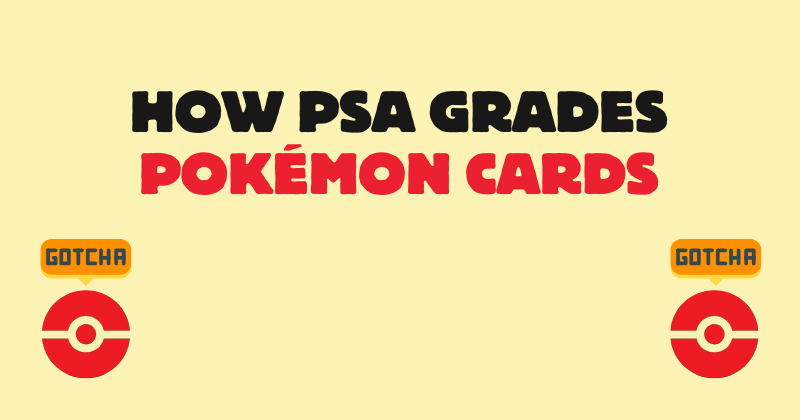This post is part of our research into creating an AI/ChatGPT grading estimator for Pokémon cards. As part of this experiment, we’ve ordered three professionally graded cards—a PSA 10, PSA 9, and PSA 8—to study the differences in how cards are evaluated.
By understanding PSA’s grading criteria and seeing these grades in action, we aim to replicate the grading process with an AI-powered tool that can analyze centering, edges, corners, and surface conditions.
How PSA Grades Pokémon Cards
1. Centering
Centering refers to how evenly the card's artwork is positioned between its borders. PSA evaluates centering on both the front and back of the card, but the front is given more weight since it is the focal point.
Centering Measurements
PSA measures centering as a percentage, comparing the thickness of opposite borders (e.g., left vs. right or top vs. bottom). Example: If the left border is 55% of the total width and the right border is 45%, the centering is 55/45.
Centering Tolerances
SA 10 (Gem Mint)
- Front: 55/45 or better.
- Back: 75/25 or better.
PSA 9 (Mint)
- Front: 60/40 or better.
- Back: 90/10 or better.
Cards outside these tolerances receive lower grades because off-centering affects the visual appeal.
2. Corners
Corners are evaluated for sharpness, wear, and overall cleanliness. Perfect corners are sharp and free of fuzziness, bends, or dings.
How PSA Evaluates Corners
Sharpness
Perfect corners will have crisp, sharp edges. Rounded or fuzzy corners lower the grade.
Damage
Whitening, bends, or nicks on the corners are signs of wear.
Focus Areas
PSA examines corners carefully under magnification to detect subtle imperfections.
Perfect Corners for PSA 10
PSA 10 corners will look flawless, even under 10x magnification.
Minor flaws like very slight whitening can drop the card to a PSA 9.
3. Edges
Edges are the borders of the card and are examined for chipping, whitening, or other visible damage.
What PSA Looks For in Edges
Clean Edges
Edges should be smooth and free of chipping or peeling.
Whitening
Common on Pokémon cards with dark-colored borders. Any whitening can lower the grade.
Foil Damage
On holo cards, PSA looks for foil or printing damage near the edges.
Perfect Edges for PSA 10
Edges should appear crisp and clean with no whitening or wear.
Minor edge flaws can reduce the grade to PSA 9 or lower.
4. Surface
The surface of the card is evaluated for scratches, stains, dents, creases, and overall cleanliness.
What PSA Looks For in Surface Grading
Scratches
Common on holographic Pokémon cards. Even small scratches can lower the grade.
Creases or Dents
Even a light crease will usually result in a grade no higher than PSA 6.
Gloss
The card’s original finish should remain intact. Loss of gloss can indicate handling or wear.
Print Lines
Thin lines that appear during manufacturing are considered flaws and can reduce the grade.
Stains or Dirt
Cards must be free from stains, smudges, or dirt to achieve higher grades.
Perfect Surface for PSA 10
No visible scratches, creases, or surface wear under normal lighting.
Gloss and holographic shine should be intact.
Additional Considerations
PSA takes into account other factors that could affect a card’s grade:
Authenticity
PSA checks the card to ensure it’s not counterfeit or altered (e.g., trimmed or recolored).
Authenticity issues result in rejection, not grading.
Size and Shape
Cards must meet the original Pokémon card dimensions.
If the card is miscut (factory error), it will either get a lower grade or receive a "miscut" label.
Ink Quality
PSA evaluates the print quality, ensuring no discoloration or fading. Misprints are graded based on demand and quality.
PSA Grading Scale Recap
| Grade | Condition | Criteria |
|---|---|---|
| PSA 10 | Gem Mint | Perfect centering, sharp corners, clean edges, flawless surface. |
| PSA 9 | Mint | Slightly off-center, tiny imperfections like minor edge whitening. |
| PSA 8 | NM-MT | Slight wear on edges/corners, minor surface scratches. |
| PSA 7 | NM | Noticeable wear, small defects like light corner fuzz or scratches. |
| PSA 6 | EX-MT | Moderate wear, small creases, or multiple minor flaws. |
| PSA 5 | EX | Heavier wear, noticeable edge/corner issues, or small creases. |
| PSA 4 | VG-EX | Major flaws, including multiple creases or heavy wear. |
| PSA 3 | VG | Significant damage, heavy creases, rounded corners. |
| PSA 2 | Good | Heavy wear, stains, or structural damage but still complete. |
| PSA 1 | Poor | Severe damage, including tears, missing pieces, or heavy discoloration. |
How PSA Grades a Card: Step-by-Step
Initial Inspection
PSA professionals examine the card under strong lighting and magnification tools.
Measurement of Centering
Border thickness is checked to ensure the centering meets the criteria for the desired grade.
Magnified Evaluation
Corners, edges, and surface are carefully inspected for even the smallest flaws.
Grade Assignment
Multiple graders evaluate the card, and the final grade is assigned based on consensus.
Encapsulation
The card is sealed in a tamper-proof plastic case with a label showing its grade, serial number, and details.
Pro Tips for Submitting Cards
Use Card Sleeves and Toploaders
Protect your card during handling and shipping to avoid damage.
Clean the Surface Carefully
Wipe dirt or smudges off gently with a soft microfiber cloth.
Check for Flaws Before Submitting
Look for centering, edge whitening, and scratches under good lighting.
